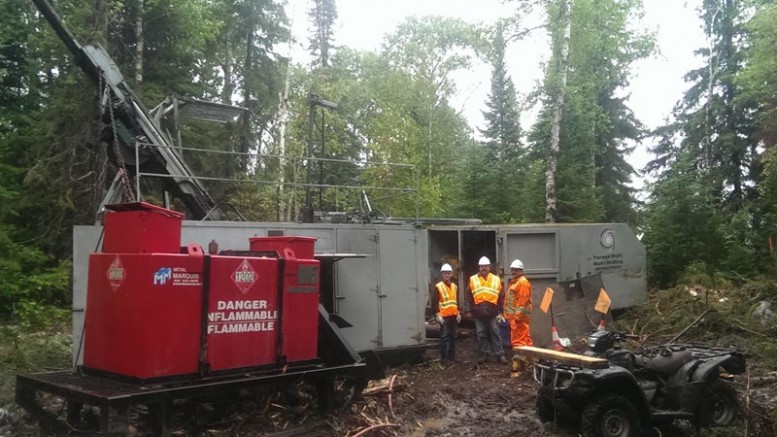Luc Lessard has worked on 11 open-pit and underground mine builds during his career as a mining engineer, including the Canadian Malartic gold mine, but he isn’t finished yet.
The president and CEO of Falco Resources (TSXV: FPC) believes the junior’s Horne 5 deposit in Rouyn-Noranda, Que., could become Canada’s next new gold mine.
Horne 5 sits below the former producing Horne mine, which was operated by Noranda from 1926 to 1976, and produced 2.5 billion lb. copper and 11.6 million oz. gold.
Since acquiring the project for $5 million in 2012, Falco has defined a prospective large bulk-tonnage resource of 6.6 million equivalent oz. gold.

Core racks at Falco Resources’ Horne 5 gold project in Quebec. Credit: Falco Resources
Mining entrepreneur Sean Roosen sits on Falco’s board as executive chairman, and Osisko Gold Royalties (TSX: OR; US-OTC: OKSKF), where Roosen is chairman and CEO, has a 16.2% stake.
Roosen is best known for parlaying an $88,000 investment in Canadian Malartic in 2004 into a $4.6-billion sale 10 years later to Agnico Eagle Mines (TSX: AEM; NYSE: AEM) and Yamana Gold (TSX: YRI; NYSE: AUY).
“With my Osisko technical services team at the helm and Roosen leading the board, this is Canadian Malartic, 2.0,” Lessard says. “We see this as the underground version of Canadian Malartic. Malartic was a big open-pit, low-grade, high-tonnage operation, and this one will be a big, low-grade, high-tonnage — but underground operation.”
Horne 5 hosts indicated resources of 58.3 million tonnes averaging 1.82 grams gold per tonne, 15.60 grams silver per tonne, 0.2% copper and 1% zinc, or 2.86 equivalent grams gold for 5.36 million equivalent oz. gold. In the inferred category, Falco has delineated 12.7 million tonnes averaging 2.10 grams gold, 26.26 grams silver, 0.2% copper and 0.6% zinc, or 3.08 equivalent grams gold for 1.25 million equivalent oz. gold.
Of the total resource, 70% of the value is gold, 15% zinc, 8% copper and the rest silver.
The company plans to use the Quemont 2 shaft on the property that runs 1.2 km deep and is wide enough to reuse, with minor rehabilitation work. Falco received a dewatering permit for the shaft on March 7.
The deposit starts at 600 metres and goes down to 2,300 metres, and Lessard estimates the shaft will be adequate for the first four or five years of production. “It gives us access to 44% of our indicated resource, and in phase two we’ll deepen it to 1.8 km, giving us access to another 47% of the indicated resource, so at that point it would access 91% of the total resource,” Lessard says. “Phasethree would then be a ramp.”
Falco’s management team is confident there is more resource to find at depth.
“We know the deposit is still open, so once we are underground at 1.2 km deep, it will be a lot cheaper to drill at depth to see if the deposit has more upside, and it will be more economic to do it than from surface,” he says. “The best grades we have are located in the deeper portion of the deposit, so we know there is more stuff to find there, and definitely higher grades to discover.”
Lessard says the preliminary economic assessment, which got underway in October 2015, should wrap up before July.
The company plans to enter a feasibility study next (“mimicking Osisko at Malartic,” Lessard says). It is already working on an environmental impact assessment, which along with the feasibility study, should be finished in the first half of 2017.
Lessard says permitting could take 18 months, with construction to follow for 12 to 18 months.
Production could start as soon as 2020.
Permitting should be straightforward, he says. This is partly because it’s in Quebec, he says, and because the company wants to pump all tailings and waste underground, so there will be less impact on the environment or surrounding communities.
“In the old Horne mine they left some openings,” he says. “We’re lucky because this thing was mined for 50 years before we were there, so there are still openings that haven’t been filled.”
On the processing side, Lessard says management envisions floating two concentrates — copper and zinc — and regrinding and leaching a residual pyrite concentrate to make gold-silver bars.
Horne 5 plans to use the smelter Noranda built 600 metres from the deposit, which is now owned by Glencore (LSE: GLEN).
Vince Metcalfe, Falco’s chief financial officer, adds that Falco benefits from its location in the Abitibi at the northern tip of Rouyn-Noranda, which gives it access to a talented labour pool. “It’s recognized as one of the best in the country, and 80% of the required suppliers are located within one hour of the project.”
Falco also doesn’t need to build a camp, because everyone can live in town, Metcalfe says, and it doesn’t need to build warehouses because all the suppliers have warehouses of their own.
“We have access to rail, but our concentrate doesn’t have to travel across the country to a different smelter,” he says.
For Lessard, who has built mines all around the world, Horne 5 is special.
“I am slowly reaching the end of my career and maybe have one or two mine builds left in me,” he says. “This one is close to my heart, as I have spent several years of my life in Rouyn-Noranda, and now I feel I can leave a great legacy to the community with the Horne 5 project.”


Be the first to comment on "Falco to move Horne 5 from PEA straight to feasibility"